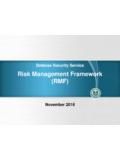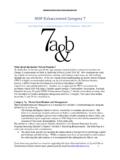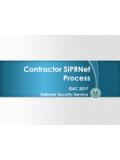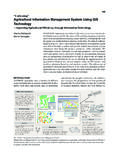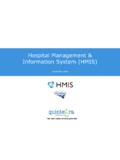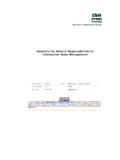Transcription of Chapter 8 Information System Security
1 Chapter 8 Information System Security Industrial Security Letter This is a special section of the Industrial Security Letter (ISL) dedicated to interpreting and clarifying the May 1, 2000 Chapter 8. The document compliments the Director of Central Intelligence Directive (DCID 6/3) "Protecting Sensitive Compartmented Information within Information Systems." The ISL provides industry with the DoD perspective on protecting classified Information while maintaining uniformity and consistency with established Department of Defense (DoD) policies. There are references to additional technical data or Information being present on the DSS website ( ) in the responses to a number of questions in this ISL. That additional Information will be posted on March 9, 2001. 1. Question: What is the implementation date of the May 1, 2000 Chapter 8?
2 Answer: The implementation date is currently scheduled for May 1, 2001. All Information Systems (IS) submitted for accreditation or reaccreditation after this date shall implement the requirements of the new Chapter . 2. Question: Will Automated Information Systems (AIS) accredited under Chapter 8 of the 1995 NISPOM retain their accreditation? Answer: Yes. Currently accredited AISs retain their accreditation for three years from the date of this ISL. Within the three-year period, contractors shall implement the requirements of the new Chapter and request reaccreditation for all IS accredited against the 1995 Chapter 8 requirements. 3. Question: When will training become available for the new Chapter 8? Answer: The DSS Academy has prepared a presentation describing the changes between the January 1995 and May 2000 version of the NISPOM Chapter 8.
3 This presentation is annotated so that contractor personnel can provide training within their own organizations. The presentation can be viewed at, or downloaded from, For a more in-depth class of Information Security that includes the new Chapter 8, the DSS Academy has updated the IS Security Procedures for Industry Course. The course will be available beginning February 2001. The Central Intelligence Agency has also developed training for DCID 6/3. DSS will post Information on that and any additional available training. 8-1-1 Section 1. Responsibilities and Duties 8-100. General. a. Information systems (IS) that are used to capture, create, store, process or distribute classified Information must be properly managed to protect against unauthorized disclosure of classified Information , loss of data integrity, and to ensure the availability of the data and System .
4 4. Question: Paragraph 8-100a states that the IS must be properly managed to protect against loss of data integrity and to ensure the availability of the data and System . Paragraph 8-400 states that integrity and availability are not covered by the National Industrial Security Program (NISP) and will be determined in additional guidance or requirements issued by the GCA. Is paragraph 8-100a addressing general Security concerns and not National Industrial Security Program Operating Manual (NISPOM) requirements? Answer: Yes. While important, data integrity and System availability are not covered by the NISP (paragraph 8-400) and will be determined in additional guidance or requirements issued by the GCA. b.
5 Protection requires a balanced approach including IS Security features to include but not limited to, administrative, operational, physical, computer, communications, and personnel controls. Protective measures commensurate with the classification of the Information , the threat, and the operational requirements associated with the environment of the IS are required. c. The requirements outlined in the following sections apply to all Information systems processing classified Information . Additional requirements for high-risk systems and data are covered in the NISPOM Supplement 5. Question: Paragraph 8-100c states that additional requirements for high-risk systems and data are covered in the NISPOM supplement.
6 What is the definition of high-risk systems and data? Answer: High-risk refers to the vulnerability and the nature of the technology, process, or data relative to other classified systems and data. For the purpose of this ISL, a high-risk System is one that requires protection above the baseline of Chapter 8 ( , multilevel) where high-risk data would be non-collateral data. NOTE: Director of Central Intelligence Directive (DCID) 6/3 is being coordinated as Chapter 8 of the NISPOM Supplement (Automated Information System Security ) the requirements of Protection Level 4 of the should be used for high risk systems and data. These requirements can be found at 8-101. Responsibilities.
7 A. The CSA shall establish a line of authority for training, oversight, program review, certification, and accreditation of IS used by contractors for the processing of classified Information . The CSA will conduct a risk management evaluation based on the contractor's facility, the classification, and sensitivity of the Information processed. The evaluation must ensure that a balanced, cost-effective application of Security disciplines and technologies is developed and maintained. 6. Question: Paragraph 8-101a. Will a copy of the risk management evaluation be given to the contractor? Answer: In many facilities the level of complexity of the contractor s IS program or the sensitivity of their classified projects does not warrant a formal risk management evaluation and report.
8 When one is required, the Facility Security Officer (FSO) and Information System Security Manager (ISSM) will be provided a copy. b. Contractor management will publish and promulgate an IS Security Policy addressing the classified processing environment. Additionally, an IS Security Manager (ISSM) will be appointed with oversight responsibility for the development, implementation, and evaluation of the facility's IS Security program. Contractor management will assure that the ISSM is trained to a level commensurate with the complexity of the facility s IS. 7. Question: Paragraph 8-101b. Must the ISSM be an employee of the contractor and can an ISSM manage the IS Security program for more than one contractor?
9 Answer: The ISSM must be an employee. However, in a multiple facility organization, contractor management can appoint an employee as the ISSM with oversight responsibility for multiple facilities. The travel distance between these facilities can not be greater than one hour, the complexity of any one, or all, 8-1-2 facilities is such that only one ISSM is required, the ISSM is trained to a level commensurate with the overall complexity of all facilities, and that each facility has an appointed Information System Security Officer(s) (ISSO) that has been assigned all responsibilities identified in paragraph 8-104. 8. Question: Paragraph 8-101b. What training should the ISSM receive and how will management assure the requirement is met?
10 Answer: Contractor management should take maximum advantage of the DSS IS for Industry Course to train the ISSM. The course is offered in various locations around the country approximately 12 times a year. The ISSM can arrange to take any nationally known or government agency Information System Security training which includes testing or certification. 8-102. Designated Accrediting/Approving Authority. The CSA is the Designated Accrediting/Approving Authority (DAA) responsible for accrediting Information systems used to process classified Information in industry 9. Question: Paragraph 8-102 states the CSA is the Designated Accrediting/Approving Authority (DAA) responsible for accrediting IS used to process classified Information .
